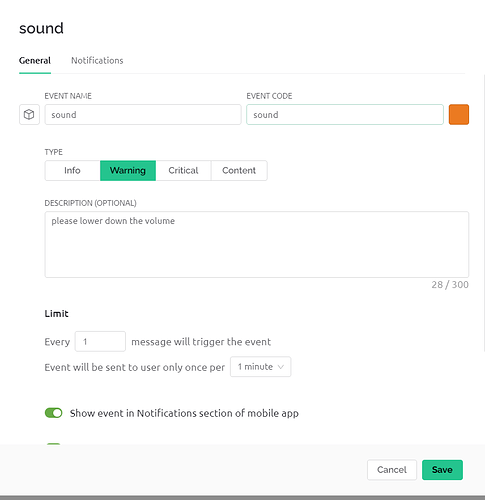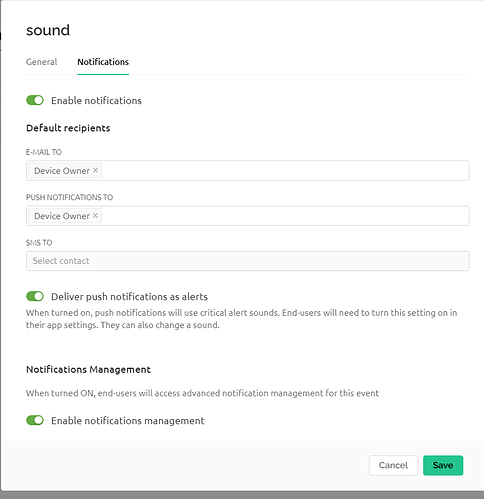Hi I have a problem with blynk notification as I wanted to give alert to the device’s user after the dose of sound passed 0.1(just example limit)
#define BLYNK_TEMPLATE_ID "TMPLYt4o1Hpd"
#define BLYNK_DEVICE_NAME "IoT Sound Monitoring"
#define BLYNK_AUTH_TOKEN "g9a7GGPdS_HdjrZg5qunXZF7gERmYE8i"
#include <WiFi.h>
#include <WiFiClient.h>
#include <BlynkSimpleEsp32.h>
#include <LiquidCrystal_I2C.h>
char auth[] = BLYNK_AUTH_TOKEN;
char ssid[] = "xdxd";
char pass[] = "12345678";
BlynkTimer timer;
const byte soundpin = 35;
const byte led1 = 27;
const byte led2 = 26;
const byte led3 = 25;
int lcdColumns = 16;
int lcdRows = 2;
int pinValue,pinValue2;
bool eventTrigger=false;
float sum2;
LiquidCrystal_I2C lcd(0x27, lcdColumns, lcdRows);
int LoopTime = 100;
byte Speaker[8] = {0b00001,0b00011,0b01111,0b01111,0b01111,0b00011,0b00001,0b00000};
BLYNK_WRITE(V6)
{
pinValue = param.asInt();
Serial.print("V1 Slider value is: ");
Serial.println(pinValue);
}
BLYNK_WRITE(V7)
{
pinValue2 = param.asInt();
Serial.print("V1 Slider value is: ");
Serial.println(pinValue2);
if(pinValue2==1){
sum2=0;
}
}
void setup() {
pinMode(soundpin, INPUT);
pinMode(led1, OUTPUT);
pinMode(led2, OUTPUT);
pinMode(led3, OUTPUT);
lcd.init();
lcd.backlight();
Serial.begin(115200);
Blynk.begin(auth, ssid, pass);
lcd.createChar(0, Speaker);
//timer.setInterval(250L, sensorDataSend);
}
void loop() {
Blynk.run();
timer.run();
int sum = 0;
int Analog;
int SPLref = 80;
int AvgRef = 130;
int n = 0;
int Sum = 0;
int value;
int size = 51;
float act[size] = {};
float tn[size];
float Average;
float dBSPLAvg;
float dose;
unsigned long ReadStartTime;
ReadStartTime = millis();
while (millis() - ReadStartTime < LoopTime) {
Analog = abs(analogRead(35));
Sum = Sum + Analog;
n++;
}
Average = ((float)Sum / n) - 95;
if (Average < 4) {
Average = 4;
}
dBSPLAvg = SPLref + 20 * log10((float)Average / AvgRef);
value = dBSPLAvg-50;
Serial.print(Average, 1);
//Serial.println("%");
if(pinValue==1){
for(int k=0;k<size;k++){
if(k==value){
++act[k];// in sec .7sec
}
}
for(int i=0;i<size;i++){
tn[i]=(8/2^((50+i)/5))*3600;// in sec
}
for(int j=0;j<size;j++){
sum2+=(act[j]/tn[j]);
}
dose=100*sum2;
Serial.print(",\t");
//Serial.println(sum2,5);
Serial.println(dose);
lcd.setCursor(0,1);
lcd.print("Dose:");
lcd.print(dose,1);
lcd.print("% ");
lcd.write(byte(0));
if(dose>0.1){
eventTrigger= true;
Blynk.email("aididhelmi0@gmail.com", "Alert", "Dosage is dangerous!");
Blynk.logEvent("Dosage is dangerous!","Remove");
}
}
Blynk.virtualWrite(V0, dBSPLAvg);
Blynk.virtualWrite(V4, dose);
digitalWrite(led1, LOW);
digitalWrite(led2, LOW);
digitalWrite(led3, LOW);
Blynk.virtualWrite(V1, 0);
Blynk.virtualWrite(V2, 0);
Blynk.virtualWrite(V3, 0);
Blynk.virtualWrite(V5, 0);
lcd.setCursor(0, 0);
lcd.clear();
//lcd.print("Loudness:");
lcd.print(dBSPLAvg, 1);
lcd.print("dB ");
if (dBSPLAvg <= 60) {
digitalWrite(led1, HIGH);
Blynk.virtualWrite(V1, 1);
lcd.print("Quite");
} else if (dBSPLAvg > 60 && dBSPLAvg < 80) {
digitalWrite(led2, HIGH);
Blynk.virtualWrite(V2, 1);
lcd.print("Moderate");
} else if (dBSPLAvg > 80) {
digitalWrite(led3, HIGH);
Blynk.virtualWrite(V3, 1);
lcd.print("Severe!");
}
delay(300);
}

